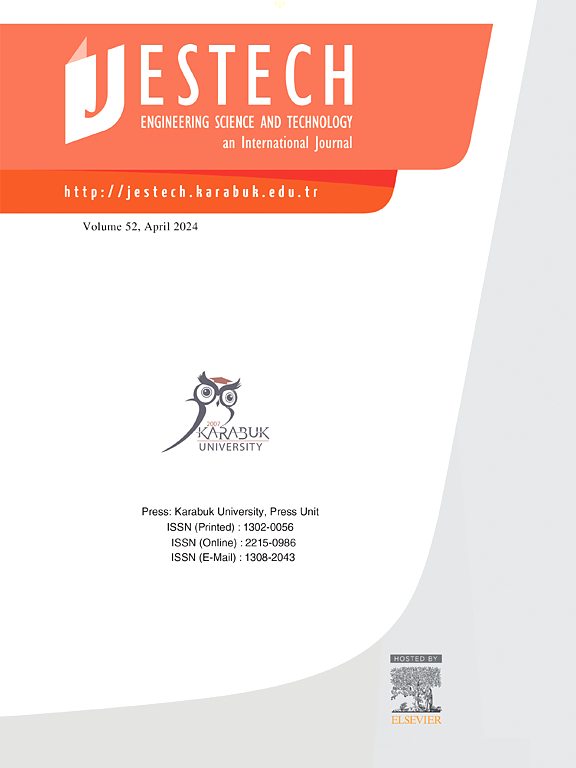Fitting method of concrete damage Poisson’s ratio model based on Kolmogorov-Arnold network
IF 5.1
2区 工程技术
Q1 ENGINEERING, MULTIDISCIPLINARY
Engineering Science and Technology-An International Journal-Jestech
Pub Date : 2025-04-10
DOI:10.1016/j.jestch.2025.102052
引用次数: 0
Abstract
The prediction model for the Poisson’s ratio of concrete damage is of significant importance in the field of Structural Health Monitoring (SHM). Seeking a concrete damage Poisson’s ratio prediction model that comprehensively reflects the characteristics of concrete while also being simple and accurate is a challenging task. This study proposes a combination of the Kolmogorov-Arnold Network (KAN), which can fit complex nonlinear relationships with high precision, and the Finite Element Method (FEM) to address this challenge. The research first summarizes the influencing factors of the concrete damage Poisson’s ratio model from classical theories, then uses data obtained from measurements and finite element analysis to train the KAN to develop the concrete damage Poisson’s ratio prediction model. Finally, the accuracy of the model is validated on a test set, and its performance is compared with that of Multi-Layer Perceptron (MLP) networks and classical models. The validation results indicate that the formula model trained by KAN achieves a Root Mean Square Error (RMSE) of 0.055 when predicting the damage Poisson’s ratio of actual test specimens, outperforming four classical models (RMSE ≥ 0.176). The novelty of this study lies in the innovative application of KAN in the concrete damage Poisson’s ratio prediction model, as well as the approach of combining a small amount of measured data with FEM to enhance the efficiency of generating training and testing data. This research not only validates the interpretability and accuracy of KAN but also demonstrates the practicality and effectiveness of the KAN and FEM combination method in the application of predicting the concrete damage Poisson’s ratio, making a significant contribution to the field.

基于Kolmogorov-Arnold网络的混凝土损伤泊松比模型拟合方法
混凝土损伤泊松比预测模型在结构健康监测(SHM)领域具有重要意义。寻找一个既能全面反映混凝土特性,又简单准确的混凝土损伤泊松比预测模型是一项具有挑战性的任务。本研究提出将可高精度拟合复杂非线性关系的柯尔莫哥洛夫-阿诺德网络(KAN)与有限元法(FEM)相结合来应对这一挑战。研究首先从经典理论中总结了混凝土破坏泊松比模型的影响因素,然后利用测量和有限元分析获得的数据训练 KAN,开发出混凝土破坏泊松比预测模型。最后,在测试集上验证了模型的准确性,并将其性能与多层感知器(MLP)网络和经典模型进行了比较。验证结果表明,由 KAN 训练的公式模型在预测实际试样的损坏泊松比时,均方根误差(RMSE)为 0.055,优于四个经典模型(RMSE ≥ 0.176)。本研究的创新之处在于将 KAN 创新性地应用于混凝土破坏泊松比预测模型,以及将少量测量数据与有限元相结合的方法,以提高生成训练和测试数据的效率。这项研究不仅验证了 KAN 的可解释性和准确性,还证明了 KAN 与有限元相结合的方法在预测混凝土破坏泊松比应用中的实用性和有效性,为该领域做出了重大贡献。
本文章由计算机程序翻译,如有差异,请以英文原文为准。
求助全文
约1分钟内获得全文
求助全文
来源期刊

Engineering Science and Technology-An International Journal-Jestech
Materials Science-Electronic, Optical and Magnetic Materials
CiteScore
11.20
自引率
3.50%
发文量
153
审稿时长
22 days
期刊介绍:
Engineering Science and Technology, an International Journal (JESTECH) (formerly Technology), a peer-reviewed quarterly engineering journal, publishes both theoretical and experimental high quality papers of permanent interest, not previously published in journals, in the field of engineering and applied science which aims to promote the theory and practice of technology and engineering. In addition to peer-reviewed original research papers, the Editorial Board welcomes original research reports, state-of-the-art reviews and communications in the broadly defined field of engineering science and technology.
The scope of JESTECH includes a wide spectrum of subjects including:
-Electrical/Electronics and Computer Engineering (Biomedical Engineering and Instrumentation; Coding, Cryptography, and Information Protection; Communications, Networks, Mobile Computing and Distributed Systems; Compilers and Operating Systems; Computer Architecture, Parallel Processing, and Dependability; Computer Vision and Robotics; Control Theory; Electromagnetic Waves, Microwave Techniques and Antennas; Embedded Systems; Integrated Circuits, VLSI Design, Testing, and CAD; Microelectromechanical Systems; Microelectronics, and Electronic Devices and Circuits; Power, Energy and Energy Conversion Systems; Signal, Image, and Speech Processing)
-Mechanical and Civil Engineering (Automotive Technologies; Biomechanics; Construction Materials; Design and Manufacturing; Dynamics and Control; Energy Generation, Utilization, Conversion, and Storage; Fluid Mechanics and Hydraulics; Heat and Mass Transfer; Micro-Nano Sciences; Renewable and Sustainable Energy Technologies; Robotics and Mechatronics; Solid Mechanics and Structure; Thermal Sciences)
-Metallurgical and Materials Engineering (Advanced Materials Science; Biomaterials; Ceramic and Inorgnanic Materials; Electronic-Magnetic Materials; Energy and Environment; Materials Characterizastion; Metallurgy; Polymers and Nanocomposites)
 求助内容:
求助内容: 应助结果提醒方式:
应助结果提醒方式:


